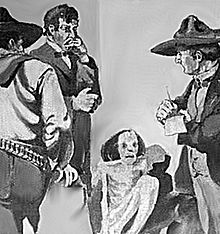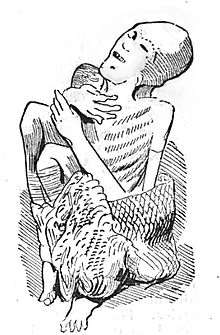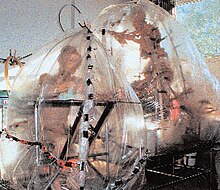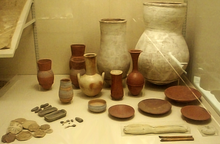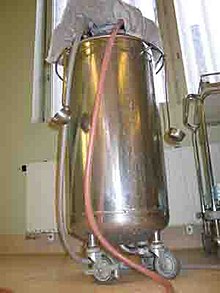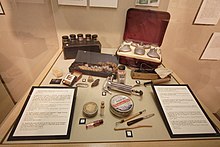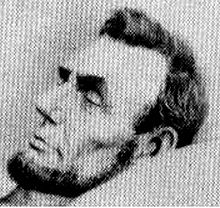Category:Bog bodies Category Talk Read Edit View history Tools Help From Wikipedia, the free encyclopedia Wikimedia Commons has media related to Bog bodies. Pages in category "Bog bodies" The following 57 pages are in this category, out of 57 total. This list may not reflect recent changes. Bog body List of bog bodies A Amcotts Moor Woman Arden Woman Aschbroeken Man B Baronstown West Man Bernuthsfeld Man Bocksten Man The Bog People Bog Dog Borremose bodies Bremervörde Gnattenbergswiesen body C Cashel Man Cladh Hallan Clonycavan Man D Damendorf Girl Damendorf Man Damendorf Woman Dätgen Man Drumkeeragh Lady E Elling Woman Emmer-Erfscheidenveen Man Esterweger Dose Child Exloërmond Man G Gallagh Man Girl of the Bareler Moor Grauballe Man Gunnister Man H Haraldskær Woman Heslington Brain Huldremose Woman Husbäke Man J Jührdenerfeld Man K Kayhausen Boy Koelbjerg Man Kreepen Man L Levänluhta Lindow Man Lindow Woman Luttra Woman M Meenybradden Woman N Nederfrederiksmose body O Old Croghan Man Osterby Man P Porsmose Man R Rendswühren Man Roum Man S Stidsholt Woman Stoneyisland Man T Tollund Man U Girl of the Uchter Moor W Weerdinge Men Windeby I Windeby Man Worsley Man Y Yde Girl Z Zweeloo Woman Media in category "Bog bodies" The following 5 files are in this category, out of 5 total. A File:Amcotts Moor Woman Shoe.jpg C File:Clonycavan reconstruction.jpg G File:Grauballe Man reconstruction.jpg W File:Windeby Reco.jpg Y File:Yde Face Reconstruction.jpg Categories: BogsDead peopleMummiesHuman remains (archaeological) Hidden category: Commons category link is on Wikidata https://en.wikipedia.org/wiki/Category:Bog_bodies File:Amcotts Moor Woman Shoe.jpg No higher resolution available. Amcotts_Moor_Woman_Shoe.jpg (250 × 110 pixels, file size: 4 KB, MIME type: image/jpeg)
Amcotts_Moor_Woman_Shoe.jpg (250 × 110 pixels, file size: 4 KB, MIME type: image/jpeg)
https://en.wikipedia.org/wiki/File:Amcotts_Moor_Woman_Shoe.jpg
https://geoltime.github.io/?Ma=1,900
Category:Mummies
Subcategories
This category has the following 8 subcategories, out of 8 total.
A
- Andean mummies (8 P)
B
- Bog bodies (57 P, 5 F)
F
- Fiction about mummies (3 C, 34 P)
G
- Guanche mummies (4 P)
H
- Human taxidermy (2 P)
T
Pages in category "Mummies"
The following 71 pages are in this category, out of 71 total. This list may not reflect recent changes.
M
O
S
X
https://en.wikipedia.org/wiki/Category:Mummies
| Umber | |
|---|---|
| Hex triplet | #635147 |
| sRGBB (r, g, b) | (99, 81, 71) |
| HSV (h, s, v) | (21°, 28%, 39%) |
| CIELChuv (L, C, h) | (36, 15, 39°) |
| Source | ColorHexa[1] |
| B: Normalized to [0–255] (byte) | |
Umber is a natural earth pigment consisting of iron oxide and manganese oxide; it has a brownish color that can vary between shades of yellow, red, and green.[3]: 39 Umber is considered one of the oldest pigments known to humans, first seen in Ajanta Caves in 200 BC-600 AD.[4]: 378 Umber's advantages are its highly versatile color, warm tone, and quick drying abilities.[5]: 148–49 While some sources indicate that umber's name comes from its geographic origin in Umbria, other scholars suggest that it derives from the Latin word umbra, which means "shadow."[6]: 250 The belief that its name derives from the word for shadow is fitting, as the color helps create shadows.[6]: 250 In addition, the color is primarily imported from Turkey, specifically Cyprus, and not Italy.[6]: 250 Umber is typically mined from open pits or underground mines and ground into a fine powder that is washed to remove impurities.[7] In the 20th century, the rise of synthetic dyes decreased the demand for natural pigments such as umber.[citation needed]
https://en.wikipedia.org/wiki/Umber#Burnt_umber
The Saltmen (Persian: مردم نمک mardom-e namak) were discovered in the Chehrabad salt mines, located on the southern part of the Hamzehlu village, on the west side of the city of Zanjan, in the Zanjan Province in Iran. By 2010, the remains of six men had been discovered, most of them accidentally killed by the collapse of galleries in which they were working.[1] The head and left foot of Salt Man 1 are on display at the National Museum of Iran in Tehran.
Discovery
In the winter of 1993, miners came across a body with long hair, a beard and some artifacts. These included the remains of a body, a lower leg inside a leather boot, three iron knives, a woollen half trouser, a silver needle, a sling, parts of a leather rope, a grindstone, a walnut, some pottery shards, some patterned textile fragments, and a few broken bones. The body had been buried in the middle of a tunnel approximately 45 metres (148 ft) in length.[2]
In 2004, another salt miner found the remains of a second man. During archaeological excavations in 2005, the remains of another two well-preserved men were found. In 2006, the Iranian Cultural Heritage News Agency partnered with the German Mining Museum in Bochum (Germany), in 2007 with the University of Oxford and the Swiss University of Zurich for thorough investigations. A scientific long-term project was started, supported by Deutsche Forschungsgemeinschaft (DFG) and British funds.[1] Four corpses, including a teenager and a woman, are kept at the Archeology Museum (Zolfaghari House) in Zanjan. A sixth corpse found in the excavation campaign 2010 was left in place at the salt mine. Three hundred pieces of fabric were found, some of which retained designs and dyes. In 2008, the Ministry of Industries and Mines canceled the mining permit.[3]
Research
After archaeological studies which included C14 dating of different samples of bones and textiles, the Salt Man was dated to about 1,700 years ago. By testing a sample of hair, the blood group B+ was determined.
Three-dimensional scans which were modeled by a scientific team led by Jalal Jalal Shokouhi[4] show fractures around the eye and other injuries which occurred before death, resulting from a hard blow. Visual characteristics included long hair and a beard; a golden earring in the left ear indicated that he was likely a person of rank or influence. The reason for his presence and death in the salt mine of Chehrabad remains a mystery.
Three of the saltmen are dated to the Parthian (247 BCE–224 CE) and Sassanid (224–651 CE) eras, and the remainder to the Achaemenid Dynasty (550–330 BCE).[3]
In a 2012 research paper,[5] it was reported that the 2200-year-old mummy of Chehrabad had tapeworm eggs from the genus Taenia in his intestine. This brings new information on ancient diet, indicating the consumption of raw or undercooked meat, and it also constitutes the earliest evidence of ancient intestinal parasites in Iran, adding to the knowledge of gastrointestinal pathogens in the Near East.[5]
See also
References
Sources
- Aali, Abolfazl; Stöllner, Thomas; Abar, Aydin; Rühli, Frank (2012). "The Salt Men of Iran: The Salt Mine of Douzlākh, Chehrābād". Archäologisches Korrespondenzblatt. Mainz: Verlag des Römisch-Germanischen Zentralmuseums. 42 (1): 61–81. ISSN 0342-734X.
- Hadian; Good; Pollard (2013). "Textiles from Douzlakh Salt Mine at Chehr Abad, Iran: A Technical and Contextual Study of Late pre-Islamic Iranian Textiles". The International Journal of Humanities of the Islamic Republic of Iran. Tarbiat Modarres University. 19 (3): 152–173. ISSN 1735-5060. Archived from the original on 19 July 2013. Retrieved 6 August 2013.
- National Museum of Iran, Description of the exhibits. Tehran.
- Ramaroli, V; Hamilton, J.; Ditchfield, P.; Fazeii, H.; Aali, A.; Coningham, R.A.E.; Pollard, A.M. (2010). "The Chehr Abad "Salt men" and the isotopic ecology of humans in ancient Iran". American Journal of Physical Anthropology. 143 (3): 343–354. doi:10.1002/ajpa.21314. PMID 20949607.
- Vatandoust, Abdolrasool (1998). Saltman: Scientific Investigations carried out on Saltman Mummified Remains and its Artifacts (1st ed.). Tehran: Research Center for Conservation od Caltural Relics (RCCCR). ISBN 964-91875-1-0.
External links
Head of Salt Man 1 on display at National Museum of Iran in Tehran
https://en.wikipedia.org/wiki/Saltmen
Aztec mummy refers to an intentionally prepared or naturally desiccated human body of Aztec origin.
Ceremonial preparation vs. natural desiccation
Distinctions must be made between intentionally prepared Aztec mummies and mummies resulting from natural desiccation. Prepared Aztec mummy “bundles” consist of the remains of the deceased placed in a woven bag or wrap which was often adorned with a ceremonial mask.[1] Most of the more widely known examples of Aztec mummies, which formed the basis of popular traveling exhibitions[2] and museum exhibits[3] in the 19th Century, were likely the product of natural desiccation rather than an intentional mummification process.
Unlike Egyptian mummies, which were typically placed in an extended supine position within a sarcophagus, Aztec mummies were typically placed in seated positions. To maintain the pose of the body, the remains were often secured within a cloth wrapping, sometimes with rope.
Symbolism in Aztec hieroglyphs
A mummy is the Aztec hieroglyph for death.[4] In Aztec written documentation of historical events, such as the death of a ruler or warrior, a mummy glyph will be connected to a glyph denoting the person's name and another glyph denoting the year of the event.
The pictured example of Aztec hieroglyphs shows the mummy of a human figure bound with ropes, with a crown on its head, indicating the death of a ruler. The small water-animal attached to the crown by a cord shows that the dead ruler's name was Ahuitzotl, that being the Aztec word for "water-animal". The right half of the glyph shows a man seated upon a dais, with a crown on his head and a speech-scroll issuing from his mouth. The Aztec word for ruler was "tlahtouani", "he who speaks", shown graphically by the speech-scroll. Finally both figures are attached by cords to the circle above, which represents the year "10-Rabbit" (1502 A.D.), indicating the date of this event.[4]
Cultural references
In the late 19th Century, resurrected Aztec mummies replaced their Egyptian counterparts in popular American stories such as The Squaw Hollow Sensation, which appeared in 1879 and told the story of "the discovery and revival of a 1000-year-old Aztec mummy".[5][6] Aztec mummy-themed stories continued in American novels, films, comic books, and television throughout the 20th century and into the 21st century. Notable examples include fictional confrontations between Aztec mummies and the Lone Ranger (comic book), Kolchak (television), and Mil Mascaras vs. the Aztec Mummy (film).
Aztec mummy-themed horror films produced in Mexico include La Momia Azteca, which was the first of a trilogy of films produced in 1957 featuring a resurrected Aztec warrior named Popoca, followed by The Curse of the Aztec Mummy and The Robot vs. The Aztec Mummy. The later film Wrestling Women vs. the Aztec Mummy (1964) featured a resurrected Aztec warrior named Tezomoc,[7] and Mexican mummies were again featured in The Mummies of Guanajuato.[8] Unlike the Aztec mummies appearing in most American film and television productions, which are typically mummified as part of a ceremonial process similar to Egyptian mummies, Mexican horror films typically involve the resurrection of naturally desiccated Aztec warriors. The 2007 American film Mil Mascaras vs. the Aztec Mummy, starring the aforementioned Mexican superstar wrestler Mil Máscaras, features the ceremonial resurrection of a mummy in a sarcophagus that is more reminiscent of Egyptian mummies than Aztec ones.
References
{{cite journal}}: Missing or empty |title= (help)
https://en.wikipedia.org/wiki/Aztec_mummy
Plastination is a technique or process used in anatomy to preserve bodies or body parts, first developed by Gunther von Hagens in 1977.[1] The water and fat are replaced by certain plastics, yielding specimens that can be touched, do not smell or decay, and even retain most properties of the original sample.[2]
Process
Four steps are followed in the standard process of plastination: fixation, dehydration, forced impregnation in a vacuum, and hardening.[3] Water and lipid tissues are replaced by curable polymers, which include silicone, epoxy, and polyester-copolymer.[3]
The first step of plastination, fixation,[4] frequently uses a formaldehyde-based solution, and serves two functions. Dissecting the specimen to show specific anatomical elements can be time-consuming. Formaldehyde or other preserving solutions help prevent decomposition of the tissues. They may also confer a degree of rigidity. This can be beneficial in maintaining the shape or arrangement of a specimen. A stomach might be inflated or a leg bent at the knee, for example.
After any necessary dissections have taken place, the specimen is placed in a bath of acetone (freezing point −95 °C [-139 °F]) at −20° to −30 °C (−4 to −22 °F). The volume of the bath should be 10 times that of the specimen. The acetone is renewed two times over the course of six weeks. The acetone draws out all the water and replaces it inside the cells.[5]
In the third step, the specimen is then placed in a bath of liquid polymer, such as silicone rubber, polyester, or epoxy resin. In a partial vacuum, the acetone is made to boil at a low temperature. As the acetone vaporizes and leaves the cells, it draws the liquid polymer in behind it, leaving a cell filled with liquid plastic.[5]
The plastic must then be cured with gas, heat, or ultraviolet light, to harden it.[4]
Specimens, which can vary from a full human body to a small piece of an animal organ, are known as 'plastinates'.[citation needed] Once plastinated, the specimens and bodies are further manipulated and positioned prior to curing (hardening) of the polymer chains.[citation needed]
https://en.wikipedia.org/wiki/Plastination
Siberia
In 1993, a team of Russian archaeologists led by Dr. Natalia Polosmak discovered the Siberian Ice Maiden, a Scytho-Siberian woman, on the Ukok Plateau in the Altai Mountains near the Mongolian border.[63] The mummy was naturally frozen due to the severe climatic conditions of the Siberian steppe. Also known as Princess Ukok, the mummy was dressed in finely detailed clothing and wore an elaborate headdress and jewelry. Alongside her body were buried six decorated horses and a symbolic meal for her last journey.[64] Her left arm and hand were tattooed with animal style figures, including a highly stylized deer.[63]
The Ice Maiden has been a source of some recent controversy. The mummy's skin has suffered some slight decay, and the tattoos have faded since the excavation. Some residents of the Altai Republic, formed after the breakup of the Soviet Union, have requested the return of the Ice Maiden, who is currently stored in Novosibirsk in Siberia.[63][64][65]
Another Siberian mummy, a man, was discovered much earlier in 1929. His skin was also marked with tattoos of two monsters resembling griffins, which decorated his chest, and three partially obliterated images which seem to represent two deer and a mountain goat on his left arm.[63]
Philippines
Philippine mummies are called Kabayan Mummies. They are common in Igorot culture and their heritage. The mummies are found in some areas named Kabayan, Sagada and among others. The mummies are dated between the 14th and 19th centuries.
https://en.wikipedia.org/wiki/Mummy#Siberia
Incorruptibility is a Roman Catholic and Eastern Orthodox belief that divine intervention allows some human bodies (specifically saints and beati) to completely or partially avoid the normal process of decomposition after death as a sign of their holiness.
Incorruptibility is thought to occur even in the presence of factors which normally hasten decomposition, as in the cases of saints Catherine of Genoa, Julie Billiart and Francis Xavier.[1]
Roman Catholicism
In Roman Catholicism, if a body is judged as incorruptible after death, this is most often seen as a sign that the individual is a saint. Canon law allows inspection of the body so that relics can be taken and sent to Rome. The relics must be sealed with wax and the body must be replaced after inspection. These ritual inspections are performed very rarely and can only be performed by a bishop according to the requirements of canon law. A pontifical commission can authorize inspection of the relics and demand a written report.[2] After solemn inspection of the relics, it can be decided that the body is presented in an open reliquary and displayed for veneration. Catholic law allows saints to be buried under the altar, so Mass can be celebrated above the remains.
The remains of Bernadette Soubirous were inspected multiple times, and reports by the church tribunal confirmed that the body was preserved. The opening of the coffin was attended by multiple canons, the mayor and the bishop in 1919, and repeated in 1925.[3] However, the face and hands were covered with a wax mask.[4]
Not every saint, however, is expected to have an incorruptible corpse. Although believers see incorruptibility as supernatural, it is no longer counted as a miracle in the recognition of a saint.[5]
Embalmed bodies were not recognized as incorruptibles. For example, although the body of Pope John XXIII remained in a remarkably intact state after its exhumation, Church officials remarked that the body had been embalmed[6] and additionally there was a lack of oxygen in his sealed triple coffin.[7]
Incorruptibility is seen as distinct from the good preservation of a body, or from mummification. Incorruptible bodies are often said to have the odour of sanctity, exuding a sweet or floral, pleasant aroma.
Saints
The body of Saint Zita, found to be incorrupt by the Catholic Church. (born c. 1218 - d. 27 April 1272).
The body of Saint Rita of Cascia, found to be incorrupt by the Catholic Church. (b. 1381 - d. May 22, 1457).
Casket of Saint Francis Xavier in the Basilica of Bom Jesus in Goa, India
The body of Saint Virginia Centurione, found to be incorrupt by the Catholic Church. (b. April 2, 1587 – d. December 15, 1651).
The body of Saint Bernadette of Lourdes with wax face and hand coverings, declared to appear incorrupt by a committee in 1909 (subsequent exhumations indicated corruption). (b. January 7, 1844 – d. April 16, 1879).
The body of Saint John Mary Vianney wearing a wax mask, found to be incorrupt by the Catholic Church. (b. 8 May 1786 – d. 4 August 1859).
The body of Saint Catherine Labouré, found to be incorrupt by the Catholic Church. (b. May 2, 1806 – d. December 31, 1876).
Beatified
- Saint Margaret of Castello
- Alfredo Ildefonso Schuster
- Pier Giorgio Frassati
- Charles I of Austria
- Maria Angela Astorch
- Sebastian de Aparicio
Eastern Orthodoxy
To the Eastern Orthodox, a distinction is made between natural mummification and what is believed to be supernatural incorruptibility. While incorruptibility is not generally deemed to be a prerequisite for sainthood, there are reportedly many Eastern Orthodox saints whose bodies have been found to be incorrupt and are in much veneration.[citation needed] These include:
- Saint Alexander of Svir – the incorrupt relics of the saint were removed from the Svir Monastery by the Bolsheviks on December 20, 1918, after several unsuccessful attempts to confiscate them. Finally, the holy relics were sent to Petrograd's Military Medical Academy. There they remained for nearly eighty years. A second uncovering of St Alexander's relics took place in December 1997, before their return to the Svir Monastery.[8]
- Saints Anthony, John, and Eustathios
- Saint Dionysios of Zakynthos
- Saint Elizabeth
- Saint Gerasimus of Kefalonia
- Saint Ioasaph of Belgorod – In 1918 the Bolsheviks removed Saint Ioasaph's relics from his shrine in the cathedral of the Holy Trinity at Belgorod, and for some seventy years, their whereabouts remained unknown. In 1927, the cathedral itself was demolished. In the late 1980s, the relics were discovered in Leningrad's Museum of Religion and Atheism, and on 16 September 1991, they were solemnly returned to the new Cathedral of the Transfiguration of Our Lord in Belgorod, in the presence of Patriarch Alexy II.[9]
- Saint Job of Pochayiv
- Saint John Maximovitch of Shanghai and San Francisco
- Saint John the Russian
- Saint Nectarios of Aegina
- Saint Parascheva of the Balkans
- Saint Spyridon
- Saint Zosima
Judaism
Rabbi Louis Ginzberg in his monumental "Legends of the Jews" (Vol. 4, Chapter 10) based on the Jewish Apocrypha and Aggadah mentions an alleged case of bodily incorruptibility of the Biblical Baruch, scribe of Jeremiah (whose tomb is found in Iraq).[10]
See also
Footnotes
Literature
- Cruz, Joan Carroll (1977 and 1991). The Incorruptibles: A Study of the Incorruption of the Bodies of Various Catholic Saints and Beati, by , OCDS, TAN Books. ISBN 0-89555-066-0.
- Jeremiah, Ken (2012). Christian Mummification: An Interpretive History of the Preservation of Saints, Martyrs and Others, , OCDS, McFarland & Co., Inc. ISBN 0786465190.
External links
- "Incorrupt Bodies Of the Saints". Archived from the original on 2008-06-14.
- St Dionysios of Zakynthos
- St Spyridon the Wonderworker and Bishop of Tremithus
https://en.wikipedia.org/wiki/Incorruptibility
Embalming is the art and science of preserving human remains by treating them (in its modern form with chemicals) to forestall decomposition. This is usually done to make the deceased suitable for public or private viewing as part of the funeral ceremony or keep them preserved for medical purposes in an anatomical laboratory. The three goals of embalming are sanitization, presentation, and preservation, with restoration being an important additional factor in some instances. Performed successfully, embalming can help preserve the body for a duration of many years.[1] Embalming has a very long and cross-cultural history, with many cultures giving the embalming processes a greater religious meaning.
Animal remains can also be embalmed by similar methods, but embalming is distinct from taxidermy. Embalming preserves the body intact, whereas taxidermy is the recreation of an animal's form often using only the creature's skin, fur or feathers mounted on an anatomical form.
History
It is important to note that whilst the term embalming is used for both ancient and modern methods toward preservation of a deceased person there is very little connection in terms of actual practises or final aesthetic results.
The Chinchorro culture in the Atacama desert of present-day Chile and Peru are among the earliest cultures known to have performed artificial mummification as early as 5000–6000 BCE.[1]
Perhaps the ancient culture that developed embalming to the greatest extent was Egypt. As early as the First Dynasty (3200 BCE), specialized priests were in charge of embalming and mummification. They did so by removing organs, ridding the body of moisture, and covering the body with natron.[2] The ancient Egyptians believed that mummification enabled the soul to return to the preserved corpse after death.
Other cultures known to have used embalming techniques in antiquity include the Meroites, Guanches, Peruvians, Jivaro Indians, Aztecs, Toltecs, Mayans, and Tibetan and southern Nigerian tribes.[1]
The earliest known evidence of artificial preservation in Europe was found in Osorno (Spain) and are about 5000 years old human bones covered in cinnabar for preservation, but embalming remained unusual in Europe up to the time of the Roman Empire.[1]
In China, artificially preserved remains have been recovered from the period of the Han dynasty (206 BCE – 220 CE), the main examples being those of Xin Zhui and the Mawangdui Han tombs site. While these remains have been extraordinarily well preserved, the embalming fluids and methods used are unknown.[1]
In Europe the ancient practice of artificial preservation had become widespread by about 500 CE. The period of the Middle Ages and the Renaissance is known as the anatomists' period of embalming and is characterized by an increased influence of scientific developments in medicine and the need for bodies for dissection purposes. Early methods used are documented by contemporary physicians such as Peter Forestus (1522–1597) and Ambroise Pare (1510–1590). The first attempts to inject the vascular system were made by Alessandra Giliani, who died in 1326. Various attempts and procedures have been reported by Leonardo da Vinci (1452–1519), Jacobus Berengar (1470–1550), Bartholomeo Eustachius (1520–1574), Reinier de Graaf (1641–1673), Jan Swammerdam (1637–1680), and Frederik Ruysch (1638–1731).[1]
Modern methods
The modern method of embalming involves the injection of various chemical solutions into the arterial network of the body to primarily disinfect and slow the decomposition process. William Harvey, the 17th century English physician who was the first to detail the system of blood circulation, made his discoveries by injecting colored solutions into corpses.[citation needed]
The Scottish surgeon William Hunter was the first to apply these methods to the art of embalming as part of mortuary practice. He wrote a widely read report on the appropriate methods for arterial and cavity embalming in order to preserve bodies for burial. His brother, John Hunter, applied these methods and advertised his embalming services to the general public from the mid-18th century.[citation needed]
One of his more notorious clients was dentist Martin Van Butchell. When his wife Mary died on 14 January 1775, he had her embalmed as an attraction to draw more customers. Hunter injected the body with preservatives and color additives that gave a glow to the corpse's cheeks, replaced her eyes with glass eyes, and dressed her in a fine lace dress. The body was embedded in a layer of plaster of Paris in a glass-topped coffin.[4] Butchell exhibited the body in the window of his home and many Londoners came to see it; but Butchell drew criticism for the display. A rumor, possibly started by Butchell himself, claimed that his wife's marriage certificate had specified that her husband would only have control over her estate after her death for as long as her body was kept unburied.[5]
Interest in, and demand for, embalming grew steadily in the 19th century largely for sentimental reasons. People sometimes wished to be buried at far-off locations which became possible with the advent of the railways, and mourners wanted the chance to pay their last respects beside the displayed body. Other motives behind embalming were prevention of disease and the wish to prepare funerals and burials, which were becoming more elaborate, without undue haste. After Lord Nelson was killed in the Battle of Trafalgar, his body was preserved in brandy and spirits of wine mixed with camphor and myrrh for over two months. At the time of his state funeral in 1805, his body was found to still be in excellent condition and completely plastic.[6]
Alternative methods of preservation, such as ice packing or laying the body on so called 'cooling boards', gradually lost ground to the increasingly popular and effective methods of embalming. By the mid 19th century, the newly emerging profession of businessmen-undertakers – who provided funeral and burial services – began adopting embalming methods as standard.[citation needed]
Embalming became more common in the United States during the American Civil War, when servicemen often died far from home. The wish of families for their remains to be returned home for local burial and lengthy transport from the battlefield meant it became common in the United States.[7]
The period from about 1861 is sometimes known as the funeral period of embalming and is marked by a separation of the fields of embalming by undertakers and embalming (anatomical wetting) for medical and scientific purposes.[1] Dr. Thomas Holmes received a commission from the Army Medical Corps to embalm the corpses of dead Union officers to return to their families. Military authorities also permitted private embalmers to work in military-controlled areas. The passage of Abraham Lincoln's body home for burial was made possible by embalming, and it brought the possibilities and potential of embalming to wider public notice.[citation needed]
Until the early 20th century, embalming fluids often contained arsenic until it was supplanted by more effective and less toxic chemicals. There was concern about the possibility of arsenic from embalmed bodies contaminating ground water supplies and legal concerns that people suspected of murder by arsenic poisoning might claim in defense that levels of poison in the deceased's body were the result of post-mortem embalming not homicide.[citation needed]
In 1867, the German chemist August Wilhelm von Hofmann discovered formaldehyde, whose preservative properties were soon noted, and it became the foundation for modern methods of embalming.[citation needed]
Dr. Frederic Ruysch was the first one to have used the arterial injection method for embalming. His work of embalming was so nearly perfect that people thought the dead body was actually alive; however, he only used it to prepare specimens for his anatomical work.[8]
Today
Modern embalming is most often performed to ensure a better presentation of the deceased for viewing by friends and relatives. It is also used for medical research or training.
A successful viewing of the body is considered to be helpful in the grieving process.[9][10] Embalming has the potential to prevent mourners from having to deal with the rotting and eventual putrescence of the corpse.[11] It is a general legal requirement for international repatriation of human remains (although exceptions do occur)[citation needed] and is required by a variety of laws depending on locality and circumstance, such as for extended time between death and final disposition or above-ground entombment.
Jessica Mitford and the Revisionist Position
This beneficial perception of the viewing of a properly embalmed deceased person has been challenged, however, by authors such as Jessica Mitford, who point out that there is no general consensus that viewing an embalmed corpse is somehow "therapeutic" to the bereaved, and that terms such as "memory picture" were invented by the undertakers themselves, who have a financial interest in selling the costly process of embalming to the public. Mitford also points out that, in many countries, embalming is rare, and the populace of such countries are still able to grieve normally.[12]
Terms for embalmers
An embalmer is someone who has been trained and qualified in the art and science of sanitization, presentation, and preservation of the human deceased. The term mortician is far more generic; it may refer to someone who is a funeral director, an embalmer, or just a person who prepares the deceased, with or without the formal qualification of an embalmer. Thus whilst all embalmers are morticians, many morticians are not embalmers and the terms are not intrinsically synonymous. Embalming training commonly involves formal study in anatomy, thanatology, chemistry, and specific embalming theory (to widely varied levels depending on the region of the world one lives in) combined with practical instruction in a mortuary with a resultant formal qualification granted after the passing of a final practical examination and acceptance into a recognized society of professional embalmers. The roles of a funeral director and embalmer are different, depending on the locals custom and licensing body for a region in which the funeral director and/or embalmer operate. A funeral director arranges for the final disposition of the deceased, and may or may not prepare the deceased, including embalming, for viewing (or other legal requirements).
Legal requirements over who can practice vary geographically. Some regions or countries do not have specific requirements, whilst others have clear prohibitions. In the United States, the title of an embalmer is largely based on the state in which they are licensed. Additionally, in many places, embalming is not done by specialist embalmers, but rather by doctors, medical technicians or laboratory technicians who, while they have the required anatomical or chemical knowledge, are not trained specialists in this field.[13] Today, embalming is a common practice in North America, Australia, New Zealand, Britain and Ireland, while it is much less frequent in many parts of Europe; most modern countries have embalming available in some manner.
Modern practices
As practiced in the funeral home embalming involves several distinct steps. Modern embalming techniques are not the result of a single practitioner, but rather the accumulation of many decades, even centuries, of research, trial and error, and invention. A standardized version follows below, but variation in techniques are common.
The first step in embalming is to verify the permissions and requests of the family followed by a careful plan for the deceased's preparation, including reviewing the medical certificate of death. The deceased is placed on the mortuary table in the supine anatomical position with the head elevated by a head rest. Before commencing any preparation the embalmer will verify the identity of the body (normally via wrist or leg bracelets or tags). At this point, embalmers commonly perform an initial evaluation of the deceased's condition, noting things such as rigor mortis, skin condition, edema, intravenous injection sites, presence of fecal matter, tissue gas and numerous other factors which may affect the procedure and outcome. The embalming procedure is a surgical one, albeit rather minimally invasive. The process requires significant effort over the course of multiple hours, including intensive planning, evaluation, and chemical selection.
Any clothing on the body is removed and set aside, and any personal effects such as jewelry are inventoried. A modesty cloth is commonly placed over the genitalia. The body is washed in a germicidal soap. During this process the embalmer bends, flexes, and massages the arms and legs to relieve rigor mortis. The eyes are posed using an eye cap that keeps them shut and in the proper expression. The mouth may be closed via suturing with a needle and ligature, using an adhesive, or by setting a wire into the maxilla and mandible with a needle injector, a specialized device most commonly used in North America and unique to mortuary practice. Care is taken to make the expression look as relaxed and natural as possible, and ideally, a recent photograph of the deceased in good health is used as a reference. The process of closing the mouth and eyes, shaving, etc. is collectively known as setting the features. Features may also be set after the completion of the arterial embalming process, which allows the embalmer to clean and remove any purge that occurs during the embalming process.
The actual embalming process usually involves four parts:
- Arterial embalming, which involves the injection of embalming chemicals into the blood vessels, usually via the right common carotid artery. Blood and interstitial fluids are displaced by this injection and, along with excess arterial solution, are expelled from the right jugular vein and collectively referred to as drainage. The embalming solution is injected with a centrifugal pump, and the embalmer massages the body to break up circulatory clots so as to ensure the proper distribution of the embalming fluid. This process of raising vessels with injection and drainage from a solitary location is known as a single-point injection. In cases of poor circulation of the arterial solution, additional injection points (commonly the axillary, brachial, or femoral arteries, with the ulnar, radial, and tibial vessels if necessary) are used. The corresponding veins are commonly also raised and utilized for drainage. Cases where more than one vessel is raised are referred to as multiple-point injection, with a reference to the number of vessels raised (i.e. a six-point injection or six-pointer). As a general rule, the more points needing to be raised, the greater the difficulty of the case. In some cases draining from a different site from injection (i.e. injecting arterial fluid into the right common carotid artery and draining from the right femoral vein) is referred to as a split (or sometimes cut) injection. In certain cases the embalmer may deem it necessary to perform a restricted cervical injection, which involves injecting the head of the deceased separately from the rest of body. This is done in cases where distention (swelling) has a greater chance of occurring. In many cases, an embalmer may select to perform what is known as a pre-injection. A pre-injection is a solution of chemicals that do not contain any preservative chemicals, but rather chemicals that encourage vasodilation, help disperse blood clots, and act as chelating agents. The focus of this "pre-injection" is to allow for a more complete drainage and better distribution of the arterial embalming solution.
- Cavity treatment/embalming refers to the removal of internal fluids inside body cavities via the use of an aspirator and trocar. The embalmer makes a small incision just above the navel (two inches superior and two inches to the right) and pushes the trocar into the abdominal and chest cavities. This first punctures the hollow organs and aspirates their contents. The embalmer then fills the cavities with concentrated chemicals (known as Cavity Chemicals) that contain formaldehyde, which are delivered to the chest cavity via the trocar inserted through the diaphragm.[14] The incision is either sutured closed (commonly using the purse-string or 'N' suture methods) or a "trocar button" is secured into place.
- Hypodermic embalming is a supplemental method which refers to the injection of embalming chemicals into tissue with a hypodermic needle and syringe, which is generally used as needed on a case-by-case basis to treat areas where arterial fluid has not been successfully distributed during the main arterial injection.
- Surface embalming, another supplemental method, utilizes embalming chemicals to preserve and restore areas directly on the skin's surface and other superficial areas as well as areas of damage such as from accident, decomposition, cancerous growths, or skin donation.
The duration of an embalming can vary greatly, but a common approximate time of between two and four hours to complete an embalming is typical. However, an embalming case that presents excessive complications could require substantially longer. The treatment of someone who has undergone an autopsy, cases of extreme trauma, or the restoration of a long-bone donor are a few such examples, and embalmings which require multiple days to complete are known.
Embalming is meant to temporarily preserve the body of a deceased person. Regardless of whether embalming is performed, the type of burial or entombment, and the materials used – such as wood or metal coffins and vaults – the body of the deceased will, under most circumstances, eventually decompose. Modern embalming is done to delay decomposition so that funeral services may take place or for the purpose of shipping the remains to a distant place for disposition.
Grooming
After the body is rewashed and dried, a moisturizing cream is applied to the face, hands and arms. Ideally the deceased will usually sit for as long as possible for observation by the embalmer. After being dressed for visitation or funeral services, cosmetics are commonly, but not universally, applied to make the body appear more lifelike and to create a "memory picture" for the deceased's friends and relatives. For babies who have died, the embalmer may apply a light cosmetic massage cream after embalming to provide a natural appearance; massage cream is also used on the face to prevent it from dehydrating, and the infant's mouth is often kept slightly open for a more natural expression. If possible, the funeral director uses a light, translucent cosmetic; sometimes, heavier, opaque cosmetics are used to hide bruises, cuts, or discolored areas. Makeup is applied to the lips to mimic their natural color. Sometimes a very pale or light pink lipstick is applied on males, while brighter colored lipstick is applied to females. Hair gel or baby oil is applied to style short hair; while hairspray is applied to style long hair. Powders (especially baby powder) are applied to the body to eliminate odors, and it is also applied to the face to achieve a matte and fresh effect to prevent oiliness of the corpse. Mortuary cosmeticizing is not done for the same reason as make-up for living people; rather, it is designed to add depth and dimension to a person's features that lack of blood circulation has removed. Warm areas – where blood vessels in living people are superficial, such as the cheeks, chin, and knuckles – have subtle reds added to recreate this effect, while browns are added to the palpebrae (eyelids) to add depth, especially important as viewing in a coffin creates an unusual perspective rarely seen in everyday life. During the viewing, pink-colored lighting is sometimes used near the body to lend a warmer tone to the deceased's complexion.
A photograph of the deceased in good health is often sought to guide the embalmer's hand in restoring the body to a more lifelike appearance. Blemishes and discolorations (such as bruises, in which the discoloration is not in the circulatory system, and cannot be removed by arterial injection) occasioned by the last illness, the settling of blood, or the embalming process itself are also dealt with at this time (although some embalmers utilize hypodermic bleaching agents, such as phenol-based cauterants, during injection to lighten discoloration and allow easier cosmeticizing). It is also common for the embalmer to perform minor restoration of the deceased's appearance with tissue building chemicals and a hypodermic syringe. Tissue building chemicals (Tissue Builders) become solid with the introduction of liquids such as water or interstitial fluids. Commonly the area where the sphenoid and temporal bones meet; this can also be referred to the temples. In the event of trauma or natural depressions on the face or hands, tissue builder can also be utilised to return those regions of the face to the expectations of the family.
Clothing
As with all funeral practises local custom, culture, religion and family request are the key determiners of clothing for the deceased. In the Western world, men are usually buried in business attire, such as a suit or coat and tie, and women in semi-formal dresses or pant suits. In recent years, a change has occurred, and many individuals are now buried in less formal clothing, such as what they would have worn on a daily basis, or other favorite attire. The clothing used can also reflect the deceased person's profession or vocation: priests and ministers are often dressed in their liturgical vestments, and military and law enforcement personnel often wear their uniform. Underwear, singlets, bras, briefs, and hosiery are all used if the family so desires, and the deceased is dressed in them as they would be in life.
In certain instances a funeral director will request a specific style of clothing, such as a collared shirt or blouse, to cover traumatic marks or autopsy incisions. In other cases clothing may be cut down the back and placed on the deceased from the front to ensure a proper fit. In many areas of Asia and Europe, the custom of dressing the body in a specially designed shroud or burial cloth, rather than in clothing used by the living, is preferred.
After the deceased has been dressed, they are generally placed in their coffin or casket. In American English, the word coffin is used to refer to an anthropoid (stretched hexagonal) form, whereas casket refers specifically to a rectangular coffin. It is common for photographs, notes, cards, and favourite personal items to be placed in the coffin with the deceased. Bulky and expensive items, such as electric guitars, are occasionally interred with a body. In some ways this mirrors the ancient practice of placing grave goods with a person for their use or enjoyment in the afterlife. In traditional Chinese culture, paper substitutes of the goods are buried or cremated with the deceased instead, as well as paper money specifically purchased for the occasion.
Chemicals
Embalming chemicals are a variety of preservatives, sanitizers, disinfectant agents, and additives used in modern embalming to temporarily delay decomposition and restore a natural appearance for viewing a body after death. A mixture of these chemicals is known as embalming fluid, and is used to preserve deceased individuals, sometimes only until the funeral, other times indefinitely.
Typical embalming fluid contains a mixture of formaldehyde, glutaraldehyde, methanol, humectants and wetting agents, and other solvents that can be used. The formaldehyde content generally ranges from 5–35%, and the methanol content may range from 9–56%.
Environmentalists sometimes have concerns about embalming because of the harmful chemicals involved and their potential interactions with the environment. Recently, more eco-friendly embalming methods have become available, including formaldehyde-free mixtures of chemicals.[15]
Specialist embalming
Badly decomposing bodies, trauma cases, frozen, or drowned bodies, and those to be transported over long distances also require special treatment beyond that for the "normal" case. The restoration of bodies and features damaged by accident or disease is commonly called restorative art or demisurgery, and all qualified embalmers have some degree of training and practice in it. For such cases, the benefit of embalming is startlingly apparent. In contrast, many people have unrealistic expectations of what a dead body should look like, due to the near-universal portrayal of dead bodies by live actors in movies and television shows. Ironically, the work of a skilled embalmer often results in the deceased appearing natural enough that the embalmer appears to have done nothing at all. Normally, a better result can be achieved when a photograph and the decedent's regular make-up (if worn) are available to help make the deceased appear more as they did when alive.
Embalming autopsy cases differs from standard embalming because the nature of the post mortem examination irrevocably disrupts the circulatory system, due to the removal of the organs and viscera. In these cases, a six-point injection is made through the two iliac or femoral arteries, subclavian or axillary vessels, and common carotids, with the viscera treated separately with cavity fluid or a special embalming powder in a viscera bag.
Long-term preservation requires different techniques, such as using stronger preservatives and multiple injection sites to ensure thorough saturation of body tissues.
For anatomy education
A rather different process is used for cadavers embalmed for dissection by medical professionals, students, and researchers. Here, the first priority is for long-term preservation, not presentation. As such, medical embalmers use anatomical wetting fluids that contain concentrated formaldehyde (37–40%, known as formalin) or glutaraldehyde and phenol, and are made without dyes or perfumes. Many embalming chemical companies make specialized anatomical embalming fluids.
Anatomical embalming is performed into a closed circulatory system. The fluid is usually injected with an embalming machine into an artery under high pressure and flow, and allowed to swell and saturate the tissues. After the deceased is left to sit for a number of hours, the venous system is generally opened and the fluid allowed to drain out, although many anatomical embalmers do not use any drainage technique.
Anatomical embalmers may choose to use gravity-feed embalming, where the container dispensing the embalming fluid is elevated above the body's level, and fluid is slowly introduced over an extended time, sometimes as long as several days. Unlike standard arterial embalming, no drainage occurs, and the body distends extensively with fluid. The distension eventually reduces, often under extended (up to six months) refrigeration, leaving a fairly normal appearance. No separate cavity treatment of the internal organs is given. Anatomically embalmed cadavers have a typically uniform grey colouration, due both to the high formaldehyde concentration mixed with the blood and the lack of red colouration agents commonly added to standard, nonmedical, embalming fluids. Formaldehyde mixed with blood causes the grey discoloration also known as "formaldehyde grey" or "embalmer's grey".
A new embalming technique developed gradually since the 1960s by anatomist Walter Thiel at the Graz Anatomy Institute in Austria has been the subject of various academic papers, as the cadaver retains the body's natural color, texture and plasticity after the process.[12] The method uses 4-chloro-3-methylphenol and various salts for fixation, boric acid for disinfection, and ethylene glycol for the preservation of tissue plasticity.[13] The embalmed cadavers are used in anatomical research, surgical and anaesthesia training, preoperative test procedures, and CT image quality studies.[14]
Religious practices
Opinions differ among different faiths as to the permissibility of embalming. A brief overview of some of the larger faiths positions are:
- Most branches and denominations of the Christian faith allow embalming. Some bodies within Eastern Orthodoxy profess an absolute ban on embalming except when required by law or other necessity,[16] while others may discourage but do not prohibit it.[17] In most Christian denominations, the decision on embalming is the preference of the deceased's family rather than for church policy or theological viewpoint.
- The Church of Jesus Christ of Latter-day Saints does not discourage or prohibit embalming. Often, due to the custom of church members dressing the deceased, embalming is given preference.
- Some Neopagans discourage embalming, believing it unnatural to disrupt the physical recycling of the body to the Earth.
- Members of the Baháʼí Faith are not embalmed. Instead, the body is washed and then placed in a cotton, linen, or silk shroud.
- Zoroastrians traditionally hold a type of sky burial within a structure known as a Tower of Silence in which the body is exposed to weathering and predation to dispose of the remains, thus embalming the body is contrary to their funeral designs.
- Traditional Jewish law forbids embalming and burial is to be done as soon as possible – preferably within 24 hours.
- In Islam, embalming of the dead is not practiced by Muslims - except in cases of necessity, such as when a body is being transported internationally and the law requires it to be embalmed. Muslims bury their deceased as soon as possible (preferably with 24 hours), to allow the soul to transition to the afterlife as soon as possible.
Notable embalmings
This section needs additional citations for verification. (January 2012) |
- Lord Nelson (1758–1805) was preserved for two months in brandy and spirits of wine mixed with camphor and myrrh after which time the body was found to be in excellent condition and completely plastic.[6]
- Various communist leaders have been embalmed and put on public display. Perhaps the most famous embalmed body of the 20th century is that of Vladimir Lenin,[18] which continues to draw crowds decades after his death in 1924, and is seen in his Moscow mausoleum. Joseph Stalin was also embalmed and placed next to Lenin, but his body was buried in 1961 during de-Stalinization. Klement Gottwald of Czechoslovakia, who died just five days after attending Stalin's funeral, was embalmed and displayed in a mausoleum at National Monument in Vitkov in Prague. However, in 1962 due to political reasons, the body was removed and cremated. Bulgarian Georgi Dimitrov was embalmed and placed on display in the Sofia Georgi Dimitrov Mausoleum. After the fall of Communism in Bulgaria, his body was buried in 1990 in the Central cemetery of Sofia. Mongolia's Khorloogiin Choibalsan, Angola's Agostinho Neto, Romania's Gheorghe Gheorghiu-Dej and Guyana's Forbes Burnham were also embalmed by the same Russian team.[19] Currently, embalmed communist leaders can also be found in the Mausoleum of Mao Zedong, the Ho Chi Minh Mausoleum, and the Kumsusan Palace of the Sun for Kim Il Sung and Kim Jong Il.
- The botched embalming of Pope Pius XII (1876–1958; pope 1939–1958) by a charlatan doctor – which only sped up the rate of decomposition – led to his body turning black and his nose falling off while lying in state, and the body disintegrated in the coffin. The Swiss Guards stationed around Pius XII's body were forced to change shifts every 10 to 15 minutes, since the body's odor caused some guards to pass out. The doctor who performed the embalming had also taken photos of the pontiff in his death throes, intending to sell them to tabloids. The Italian tabloids refused to buy the photos, and the doctor was banned from entering the Vatican City-State by John XXIII, who furthermore prohibited any photography of a deceased pope until the body is properly vested and laid out.
- Charles XII (1682–1718) is one of several Swedish kings to have been embalmed. When Charles XII's sarcophagus was opened in 1917, his features were still recognizable, almost 200 years after his death. Photographs of his remains clearly show the gunshot wound to his head leading to his death.
- The body of Pope John XXIII (1881–1963; pope 1958–1963) is on display on an altar on the main floor of the Basilica of Saint Peter after having been exhumed from the grottoes beneath the main altar and has retained an extremely well-preserved state. If a body's remains do not decompose, contrary to expectations, it is often treated as a miracle. However, the case of John XXIII's body did not enjoy the same acclamation, as it was held to have been due to embalming and adipocere formation.
- The body of Pope Pius X (1835–1914; pope 1903–1914) lies in a crystal coffin, in the Chapel of the Presentation of the Virgin Mary. On 17 February 1952, Pius X's body was transferred from the crypt of the Vatican grotto. The body is dressed in pontifical robes, while the face and hands are covered with silver. He lies within a glass and bronze-work sarcophagus for the faithful to see. Papal physicians had been in the habit of removing organs to aid the embalming process. Pius X expressly prohibited this, however, and none of his successors has allowed the practice to be reinstituted.
- Murdered civil rights activist Medgar Evers was so well embalmed that a valid autopsy was able to be performed on his corpse decades after his death, and this helped secure the conviction of his killer.
- Famous Russian surgeon and scientist N. I. Pirogov was embalmed after his death in 1881. He was embalmed using the technique he himself developed. His body rests in a church in Vinnitsa, Ukraine. In contrast to the corpse of Lenin, which undergoes thorough maintenance in a special underground clinic twice a week, the body of Pirogov rests untouched and unchanging – reportedly only dust has to be brushed off of it. It rests at room temperature in a glass-lid coffin (while Lenin's body is preserved at a constant low temperature).
- Abraham Lincoln was embalmed after his assassination in 1865. To prevent anyone stealing Lincoln's body, Lincoln's eldest son Robert called for Lincoln's exhumation in 1901 to be buried in a concrete vault in the burial room of his tomb in Springfield, Illinois. Fearing that his body would have been stolen in the interim, Lincoln's coffin was opened, and his features were still recognizable, 36 years after his death.
- Rosalia Lombardo, who died at age one on 6 December 1920, was one of the last corpses to be interred in the Capuchin catacombs of Palermo, Sicily before the local authorities banned the practice. Nicknamed the 'Sleeping Beauty', Rosalia's body is still perfectly intact. Embalmed by Alfredo Salafia, she is in a glass case, looking very much like a surreal doll.
- Eva Perón was embalmed by Dr. Pedro Ara, as ordered by her husband Juan Perón. The body was preserved to look like it was in a sleep-like state. The procedure worked and the body showed no signs of decomposition when Eva was interred at her final resting place many years after the initial procedure.
- Kemal Atatürk was embalmed. His remains were originally laid to rest in the Ethnography Museum of Ankara from 10 November 1938 to 10 November 1953. He was subsequently moved to Anıtkabir in Ankara, Turkey, buried in a 42-ton sarcophagus.
- Chiang Kai-shek and Chiang Ching-kuo were embalmed and rest at Cihu Mausoleum and Touliao Mausoleum in Daxi District, Taoyuan City, Taiwan.
- Francisco Franco was embalmed. His remains were originally laid to rest in the Valley of the Fallen from 1975 to 2019. He was subsequently moved to Mingorrubio Cemetery, El Pardo, Madrid, Spain.
- Ferdinand Marcos was embalmed in Hawaii upon his death. His body was flown home and is on display at Marcos Museum and Mausoleum in Batac, Ilocos Norte, Philippines from 1993 to 18 November 2016.
- Diana, Princess of Wales was embalmed shortly after her death in France in August 1997. The decision to embalm her provoked conspiracy theories that she was pregnant; conspiracists claimed, incorrectly, that the embalming fluid would have destroyed any evidence of fetal presence in her womb. The official explanation for the embalming was that the warm conditions in the chapel of rest where her body was laid out would have sped up the decomposition of the remains.
- When the Basilica of Saint-Denis was desecrated by French revolutionaries in 1793, the body of Henry IV was so well preserved it was displayed two days before being thrown in a mass grave, and a new death mask was able to be made. Likewise, Louis XIII was still recognisable thanks to his well preserved moustache. Turenne was so well preserved that looters first thought he was still alive.
- Maria II of Portugal died in childbirth on 15 November 1853 at the age of 34. She was embalmed the following day. In a letter dated 28 November 1853, the Duchess of Ficalho, the queen's lady-in-waiting, reported the outcome to her brother, the 2nd Count of Lavradio:
"Sad embalming, which took place on November 16th, I was always there. The Infante's (prince) and the Queen's lasted seven hours. Once that affliction was over, it was time to put the clothes on, which was almost impossible due to the state of dissolution [of the body] of Her Majesty, but it was done as well as possible, bearing the Orders and the Royal Mantle, but it was necessary to close the coffin, because it's not possible to describe the state of dissolution."[20]
- Between February and September 2012, researchers at the University of São Paulo in Brazil exhumed the remains of Emperor Pedro I of Brazil (also King of Portugal as Pedro IV; 1798–1834) and his two wives Empress Maria Leopoldina (1797–1826) and Empress Amélie (1812–1873). They were surprised to find that the body of the latter had been mummified. Skin, hair and internal organs were preserved. Examinations at the Hospital das Clínicas found an incision in the empress' jugular vein. Aromatics such as camphor and myrrh were injected into the incision during the embalming process. "It certainly helped to nullify the decomposition", said Brazilian archaeologist Valdirene Ambiel, responsible for the research. She added that another contributing factor was the casket, saying it was so hermetically sealed that there were no micro-organisms in it. Before the reburial, scientists reembalmed Amélie's mummified body using a method similar to the first one.[21][22]
- Pedro II of Brazil died during his exile in France in 1891 at the age of 66. He was embalmed on December 5, the day of his death. During the process, six liters of hydrochloride of zinc and aluminum was injected into his common carotid artery.[23] Three coffins were used: an inner lead-lined coffin, which contained the body, and two outer coffins.[24] According to Julie Anne Taddeo, a research professor of history at the University of Maryland, lead helps keep out moisture and preserve the body for longer and prevent smells and toxins from a dead body escaping.[25] Pedro II was interred in the Royal Pantheon of the House of Braganza in Lisbon, Portugal on December 12, 1891. The site had become a place of pilgrimage for Brazilians arriving in the country at the time.[26] Many people used to visit it late at night only to find the place dark. With candles given to them by a local guard, they went to the emperor's glass-topped coffin in order to see the embalmed monarch and accidentally spilled wax on the flag of the Empire of Brazil that covered it.[26] In the 1910s, Brazilian educator and archivist Luís Gastão d'Escragnolle Dória went to Europe as a scholarship student to search for historical documents about Brazil.[26] In 1912, he visited the Royal Pantheon. [26] At the occasion, he had noticed the well-preserved state of Pedro II's body, along with the clothes which he was interred in (the court dress military uniform; the collar of the Order of the Rose; and a silver crucifix sent by Pope Leo XIII in his hands), although he did find the embalming left a lot to be desired.[26] He wrote:
"His face looks like old wax. His beard, once so fine, so silky, so white, has turned ugly and yellow, like old ivory [...]. When I saw him in February 1912 I did find he was smaller than he had been in late 1909 [...]. Dom Pedro II's head rests on a pillow filled with Brazilian sand [...]. The emperor looks so different! How cruel is an imperfect embalming! Where is that majestic head, crowned in past times with that silvery silky hair? Where are his steel gleam blue eyes; the beautiful beard gilded by youthfulness and silvered by old age; his stately bearing?
Everything is gone, faded!
Involuntarily, I do compare the mummified sovereign, [...] ugly, tiny, to the giant man who, in 1886, I saw entering the São Paulo See [Cathedral], among a colossal wave of people, dominating it, seeming so many cubits taller."[26]
Pedro II's remains, as well as those of his wife Teresa Cristina, were returned to his native Brazil in 1921. The emperor and empress are interred in the Cathedral of Saint Peter of Alcantara in Petrópolis, a city Pedro II founded.
See also
References
- Rezzutti 2019, pp. 498–499.
Further reading
- Abrams, J.L. Embalming. 2008.
- Chisholm, Hugh, ed. (1911). . Encyclopædia Britannica (11th ed.). Cambridge University Press.
- Frederick, L.G.; Strub, Clarence G. [1959] (1989). The Principles and Practice of Embalming, 5th ed., Dallas, TX: Professional Training Schools Inc & Robertine Frederick. OCLC 20723376.
- Mayer, Robert G. (2000-01-27). Embalming: History, Theory and Practice, 3rd ed., McGraw-Hill/Appleton & Lange. ISBN 978-0-8385-2187-8.
- Schmitz-Esser, Romedio (2013). "Embalming and Dissecting the Corpse between East and West: From ar-Razi to Henry de Mondeville". In Classen, Albrecht (ed.). East Meets West in the Middle Ages and Early Modern Times: Transcultural Experiences in the Premodern World. Fundamentals of Medieval and Early Modern Culture. Vol. 14. Berlin and Boston: De Gruyter. pp. 611–624. doi:10.1515/9783110321517.611. ISBN 9783110328783. ISSN 1864-3396.
- Besouchet, Lídia (1993). Pedro II e o Século XIX (in Portuguese) (2nd ed.). Rio de Janeiro: Nova Fronteira. ISBN 978-85-209-0494-7.
- Rezzutti, Paulo (2019). D. Pedro II: a história não contada: O último imperador do Novo Mundo revelado por cartas e documentos inéditos (in Portuguese). Leya; 2019. ISBN 978-85-7734-677-6.
External links
- Death Care at Curlie
- BBC article on Salisbury's School of Embalming
- Infection risks and embalming by KS Creely. Institute of Occupational Medicine Research Report TM/04/01
- Archived at Ghostarchive and the Wayback Machine: TED (14 October 2011), Jae Rhim Lee: My mushroom burial suit, retrieved 1 February 2017
https://en.wikipedia.org/wiki/Embalming
Excerebration is an ancient Egyptian mummification procedure of removal of the brain from corpses prior to actual embalming. Greek writer Herodotus, a frequent visitor to Egypt, wrote in the fifth century B.C. about the process, "Having agreed on a price, the bearers go away, and the workmen, left alone in their place, embalm the body. If they do this in a perfect way, they first draw out part of the brain through the nostrils with an iron hook, and inject certain drugs into the rest".[1]
An object more than 6.8 inches long, probably made from plants in the group Monocotyledon (including palm and bamboo), would have been used for liquefying and removing the brain. The instrument would be inserted through a hole punched into the ethmoid bone near the nose via a chisel.[2][3] Some parts of the brain would be wrapped around this stick and pulled out, and the other parts would be liquefied. In order to drain the remaining liquified brain and cerebral fluid the individual would be put on their abdomen or their head would be lifted.[2]
Evolution of Excerebration
Excerebration can be traced all the way back to the Old Kingdom through Greco-Roman Egypt.[2] The evidence of excerebration consists of primarily skull base perforations. During the Old and Middle Kingdom there was a low frequency of skull perforations. Leading many authors to provide an alternative entrance via the foramen magnum.[2] Once we enter the New Kingdom it is apparent through past skulls that the primary entrance was through the base of the skull using a transnasal excerebration occurred.[2][3]
Over the millennia excerebration has changed. In the Old and Middle Kingdoms a transethmoidal excerebration was the normal form.[2] With the assistance of modern technology and CT scanning more and more evidence has arisen as to where in the skull excerebration occurred. Through many CT scans and many skulls it has been determined that over time the transethmoidal approach was shifted towards a transsphenoidal approach.[2] As more and more evidence has been compiled originally excerebration was done through a transnasal approach, which moved towards a transethmoidal approach, which finally a transsphenoidal approach. However, there is also evidence of a combined transethmoidal-transsphenoidal version of excerebration that could have been used in the Third Intermediate Period.[2]
Religious Aspects of Excerebration
In order to extract all organs from the body embalmers would make an incision on the left side of the abdomen. Similar to this, excerebration was rarely ever seen through the right nostril and almost exclusively through the left nostril.[4] Knowing that the body would have been laid with the head to the north all incisions and excerebration would have taken place on the eastern side of the body.[5][4] For convenience and accessibility, it would have been more practical to make incisions on the western side of the body or the right side, however, everything was done on the left side, signifying some degree of symbolism or religion was involved.[4] The notion that the right side was honored, while the left was inferior, is a notion common in ancient Egypt.[4][6] Not only this, but resurrection was also seen as a journey from west to east.[4][7] Therefore, one could infer that it was more honorable and respectful to the deceased if excerebration and the removal of other organs were performed via cuts made on the left or eastern side of the body.
Modern Comparisons
Many[who?] have said that Ancient Egyptians were the first to learn about the brain and document their findings. In fact they were, they have some of the oldest documentation on the spinal cord and the brain in the world.[clarification needed][4] There are also many surgeries that take a very similar approach as excerebration did in the past. Specifically now endoscopic skull base surgery can be seen directly in excerebration with their shared approach transnasally.[clarification needed] Excerebration was an important procedure in Ancient Egypt and even today a version of excerebration can be life saving for some.
See also
References
- Carus, Paul (1905). "The Conception of the Soul and the Belief in Resurrection Among the Egyptians". The Monist. 15 (3): 409–428. doi:10.5840/monist190515326. ISSN 0026-9662. JSTOR 27899609.

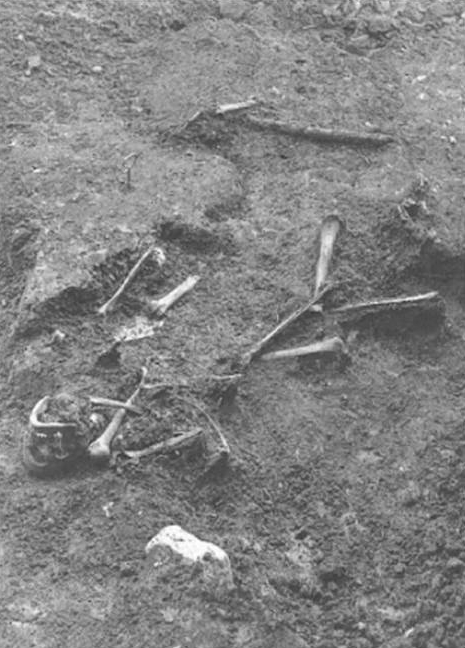
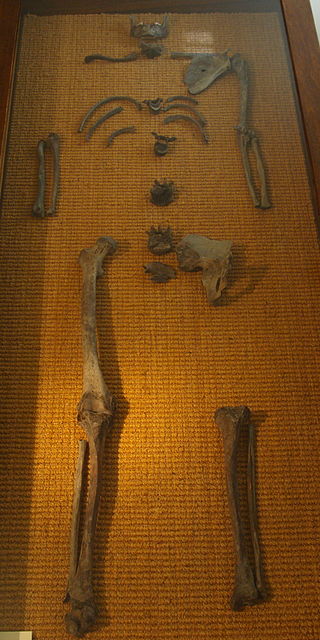


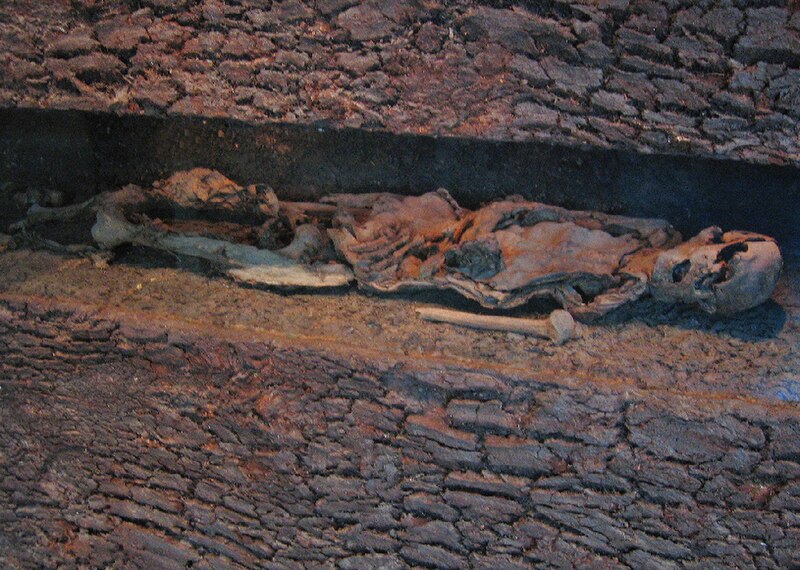


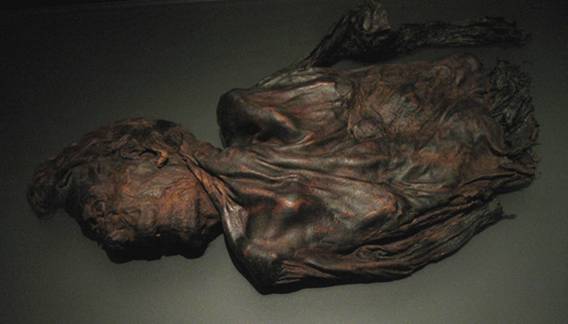



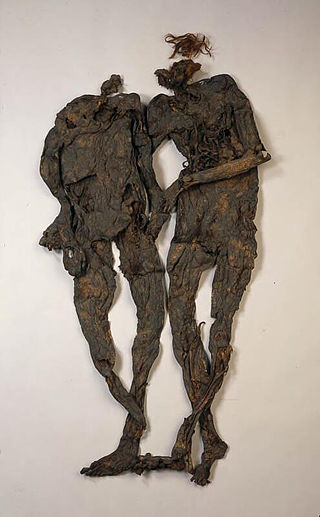
 Remains of the bog body Yde Girl. The bog body was discovered turfing a bog Yde, Province Drenthe, Netherlands on 12 Mai 1897.
Remains of the bog body Yde Girl. The bog body was discovered turfing a bog Yde, Province Drenthe, Netherlands on 12 Mai 1897.









